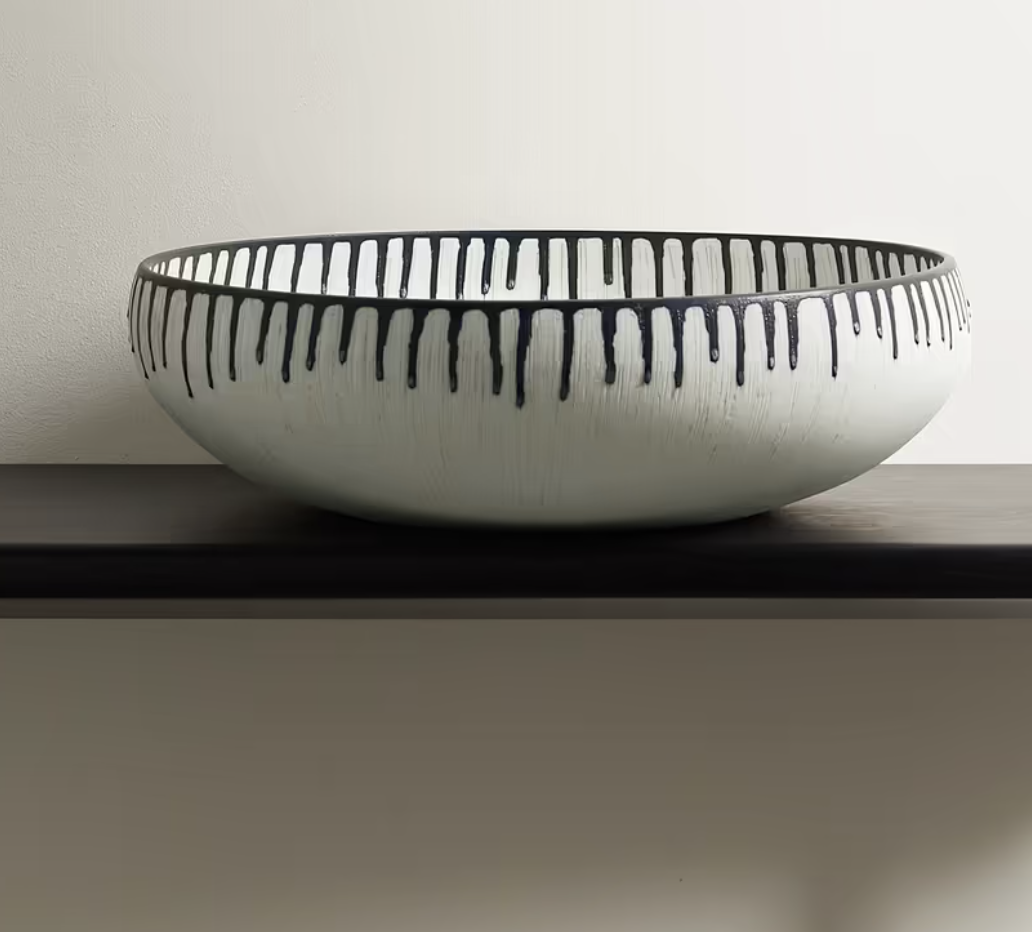10 indoor vegetable garden ideas - design experts on how to create decor that looks good enough to eat
These are the indoor vegetable garden ideas designers turn to when making homes that are filled with fresh produce, from simple pots to sophisticated systems

Growing your own vegetables is a brilliant way to eat fresh, healthy food. It can even be done without a backyard or balcony. If you want to harvest at home, these indoor vegetable garden ideas will ensure that your growing zone is as pretty as it is practical.
Like any form of green-thumbed activity, indoor garden growing is not without its challenges. One of which is planning where and how your edibles can fit into your interior.
'Indoor growing is best when it starts with a plan,' says Elizabeth Millard, garden expert and author of the Indoor Kitchen Gardening Handbook by Cool Springs Press.
'Once you have a plan in place—even if it’s a rough idea of what you want to grow—then it’s easier to take a look at other factors like space, lighting and containers, with a view toward creating the best conditions for your indoor growing adventures.'
10 indoor vegetable garden ideas
'A mix of containers based on what’s safe for edible plants, attractive in your kitchen or growing space, and easily watered is best,' says Elizabeth Millard. 'Choosing a container should have a sense of economy about it.
'Pick one that gives room for root growth, but doesn’t lead to soil waste. It should also allow for drainage.'
1. Grow chillis and herbs in a vertical grid system

'Terracotta clay pots retain heat very effectively, which is great if you have plants that love heat (like chilli peppers or eggplant), but for those that are less fond of long periods of heat, the plant roots can get burned,' says garden expert Elizabeth Millard. 'In general, though, these types of pots are visually appealing, fairly inexpensive, and have good drainage.'
Chillis are one of the best vegetables to grow in pots as they don't need a lot of space to grow well. And placing the pots in a grid system creates a space saving vertical garden. Ensure pots are positioned so that water from the top row can drip into the row below and that lowest row can drain adequately. This may mean creating a drainage channel or placing a trough beneath the last row.
2. Choose shallow ceramic bowls for micro-greens

It's very easy to have a small vegetable garden indoors - just grow small things! Instead of sewing micro-greens into plastic trays, start them off in a beautiful ceramic bowl. Their root system doesn't require much depth, so they can flourish in a shallow bowl or dish that you would be happy to display on your kitchen counter.
Micro-greens are one of the best vegetables you can grow indoors all year. And when they're ready to harvest, you'll have a plentiful display of shoots to snip onto salads, sandwiches and snacks.
'As a fun kid’s project, you could grow micro-greens in a teacup saucer, anything that can be gently watered and tended for about a week,' says Elizabeth.
3. Sew lettuce in a mix of pretty white planters

Abundant green leaves look gorgeous in white ceramic pots - vegetable container gardening at its best. So cultivate different types of lettuce in a mix of pretty planters. Choose vessels in different shapes for a characterful display.
'We think practicality and stye are paramount when growing vegetables inside,' says Alex Bates, co-founder of Bloomist. 'We love the idea of grouping a mix of different planters in the same color or material.
'Think about your design style - is it rustic, simple or all about minimalism? Or perhaps country, modernist or mid century? We have planter collections that would work across a number of aesthetics.'
4. Create an edible living wall in the kitchen for a mediterranean mix

If you're feeling adventurous, invest in an indoor edible living wall kit. Some are even equipped with an irrigation system, so are self-watering. This means you can top it up and go on vacation without worrying about your veg wilting, while you're away.
The kitchen is the obvious spot for an edible living wall, as it's where you cook and prepare meals. There's also has a water source, so place your vegetable plants as close to the sink - and a window - as possible.
'The veg that grows best in a living wall are compact and have either trailing or mounding habits,' says the plant experts at Grow Edible Walls. 'These include tumbling tomatoes, cajun bell peppers and egg plant.'
5. Line up symmetrical pots filled with salad leaves and herbs on a window sill

Lush green salad or herb leaves set against burnt orange clay is always a winning combination. Lining up terracotta pots symmetrically on a sunny window sill, will bring order and elegance to your planting.
Just ensure the plants that need shade have adequate levels and ensure they can all drain well.
'While herbs like cilantro, basil and parsley can grow together, I often prefer to grow herbs and salad leaves in separate pots indoors since their needs are slightly different,' says Dana Hopper, vegetable garden designer and co-founder of Home Grown Veggie.
'Small pottery terracotta pots look lovely - make sure the container is a bit bigger than your seedling and don't let them sit in water.'
6. Swap shelves for a hydroponic growing system
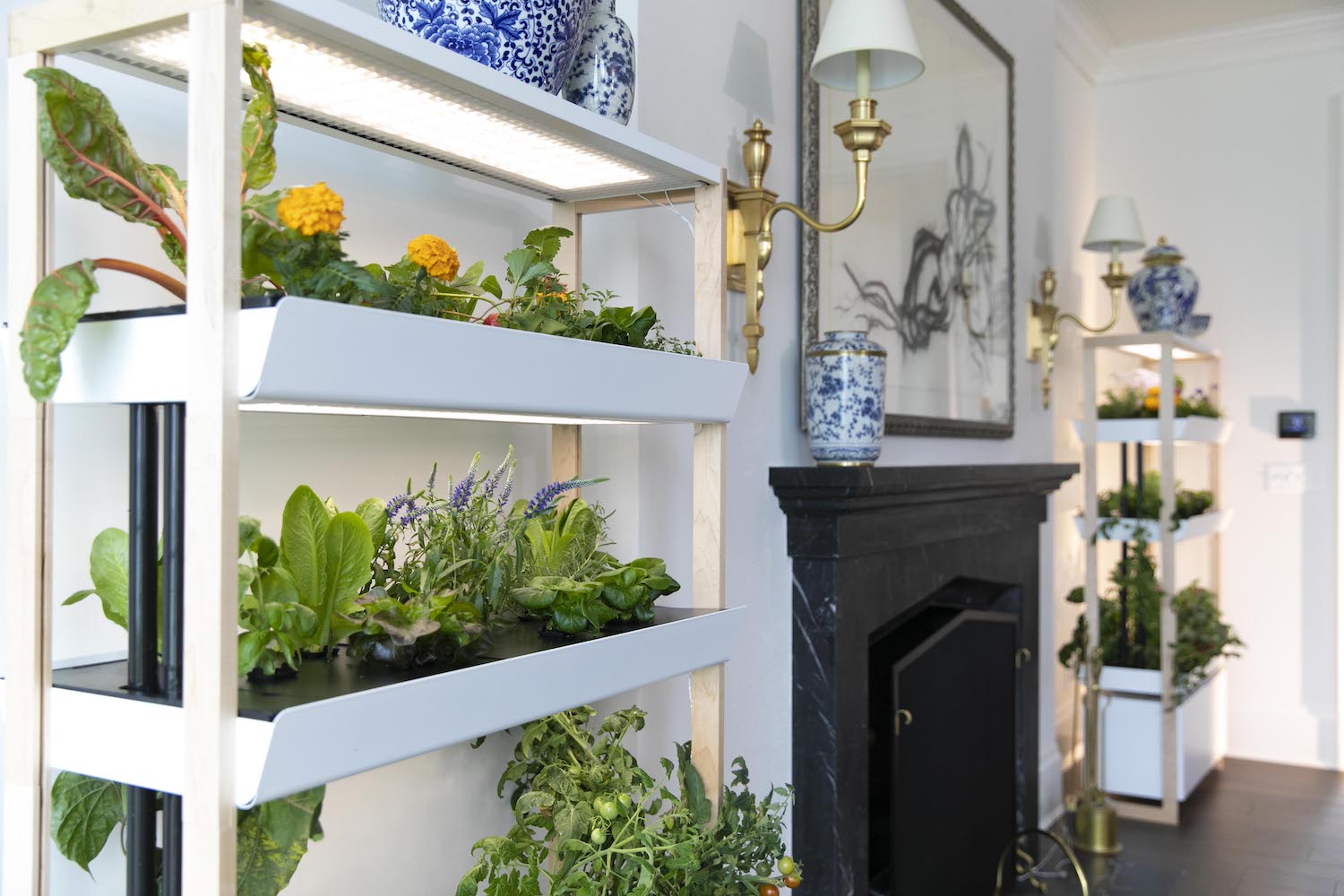
Harvesting fresh vegetables at home is made easy with a hydroponic growing system. It's less messy than using soil and most indoor plant growing systems have lighting, so there are more options when it comes to where to situate your indoor vegetable garden.
An alcove can make a great spot, so swap out book shelves that gather dust for a space to grow egg plant, tomatoes, salad leaves, beets and even cabbage, kale and pak choi. Just make sure you have an electrical outlet nearby.
'Having your growing system relatively close to a sink is also advisable,' says Angelo Kelvakis, head of R+ D for Rise Gardens. 'Then filling it up every week is a breeze, and when you need to clean it, it will also benefit from having a close proximity to water.'
'Another big plus is less of a need to think about companion planting. In soil, you need to consider heavy and light feeders because you don't want your tomatoes sucking up all the Nitrogen in the bed before your other plants can get it.
'With hydroponics, because you are balancing your nutrients every single week, you can get away with heavy and light feeders growing in the same system.'
7. Install a counter top garden
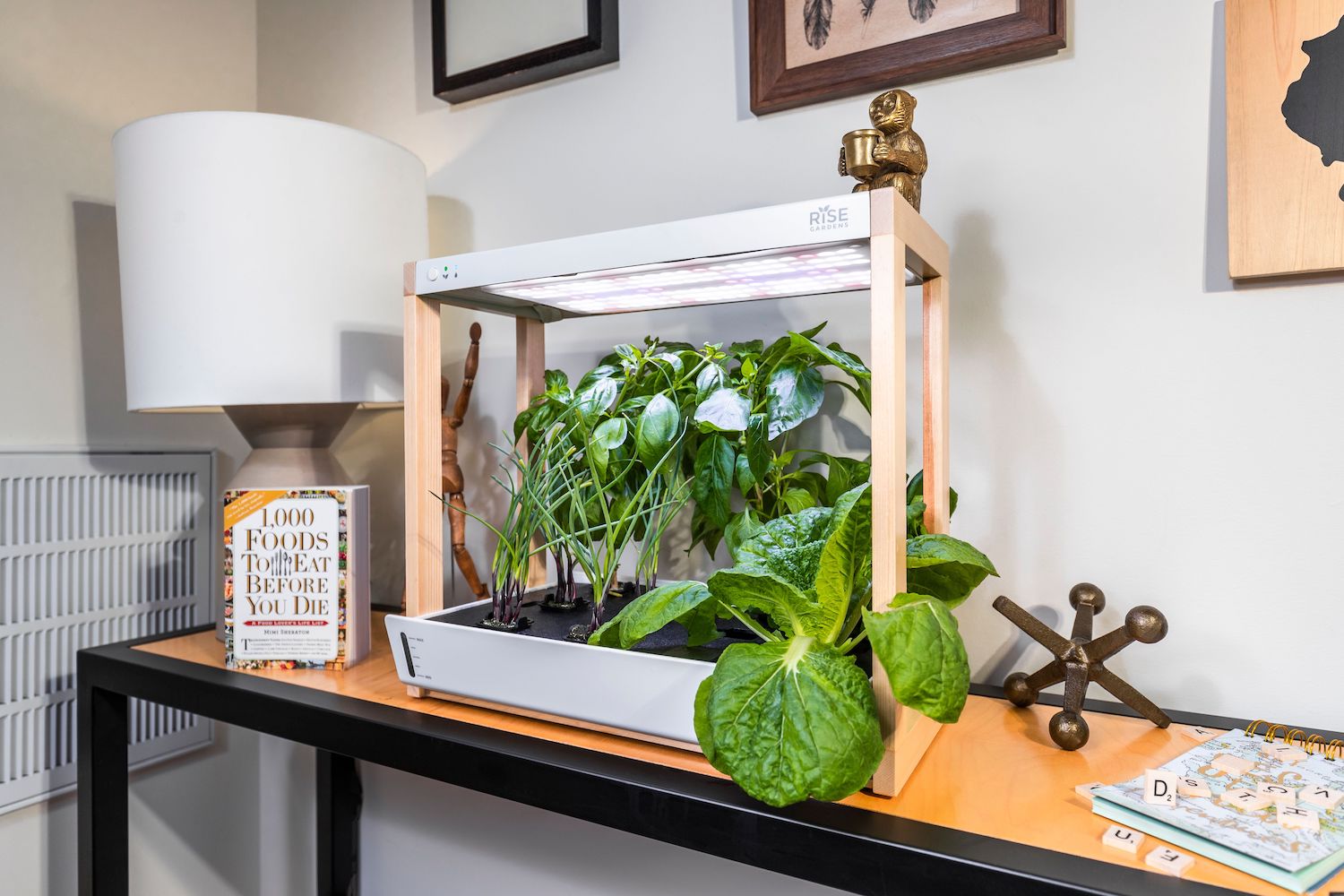
If you're starting out on an indoor growing adventure and don't have oodles of space to store pots, soil and other gardening paraphernalia, start small. A kitchen countertop hydroponic system can be a compact and convenient way to start growing fruit, veg and herbs at home.
'The Personal Garden grows salad in under 30 days,' says says Angelo Kelvakis, head of R+ D for Rise Gardens. 'Most of our leafy greens are ready to harvest in 25 days, so you can enjoy a fresh salad in a matter of weeks. It's perfect for growing herbs, little greens, rooted plants, microgreens, and flowers.
'There are also some fruiting plants like mini snackable strawberries, hot lemon pepper, and mini siam tomato that will grow well. However, most other larger plants will tend to grow outside the lights of the garden.'
8. Place small root veg in zinc planters

Contrasting tones look gorgeous, so if you want an appealing patch of ruby red beets or radishes, consider placing your potted roots in cool zinc planters. When fully grown the combo of colors will make a spectacular display. Bonus note: beets are one of the easiest low maintenance plants for indoor gardening.
Obviously, the practicalities of the container, such as size and drainage, are the main priorities. So just ensure that the potted veg has room to grow and the display planter allows them to drain adequately.
'The breadth of container options is limitless,' says Elizabeth Millard. 'I’ve seen indoor vegetables grown in children’s old sand buckets, worn-out boots and tackle boxes. But there are practicalities to keep in mind.
'For most indoor growing, you need room for the roots to expand properly. For most vegetables, most of the root mass is within the top 6 inches of soil, so choose a container that can be aerated properly.'
9. Grow leafy greens in a large timber trough

A deep timber trough is a suitable and stylish container to grow veg on a covered indoor-outdoor space like a balcony. Experiment with a small patch of greens or roots and ensure there is enough growing space between them.
'Like plants out in a field or in an outdoor raised bed, indoor plants need space apart from each other to stretch out,' says Elizabeth Millard. 'Herbs and many types of vegetables can be cozy, but they shouldn’t be crowded.
'For many indoor growing spaces, wood is a nice choice because these containers can look amazing. But wood can also be problematic when it comes to food safety—some containers are treated with very harsh chemicals to keep the wood from molding or rotting, and those toxins can leach into your edibles.
'A good solution that I employ often is to put another pot inside the wooden planter, especially if the leaves will drape over the side to hide the gap between planter and pot. It’s also possible to seal timber with a good food-grade choice as well, such as a mineral oil and beeswax or a soy sealer.'
10. Start seedlings in cartons of the same color

It's often convenient to start seedlings in plastic food containers, that would otherwise be thrown away (or recycled). This can end up looking messy though. Create some order by collecting cartons of the same color for a coordinated display on a window sill.
This way, your indoor vegetable patch will look neat and tidy in your interior - and you'll be able to easily monitor its progress.
Be The First To Know
The Livingetc newsletters are your inside source for what’s shaping interiors now - and what’s next. Discover trend forecasts, smart style ideas, and curated shopping inspiration that brings design to life. Subscribe today and stay ahead of the curve.
Jacky Parker is a London-based freelance journalist and content creator, specialising in interiors, travel and food. From buying guides and real home case studies to shopping and news pages, she produces a wide range of features for national magazines and SEO content for websites
A long-time contributor to Livingetc, as a member of the team, she regularly reports on the latest trends, speaking to experts and discovering the latest tips. Jacky has also written for other publications such as Homes and Gardens, Ideal Home, Red, Grand Designs, Sunday Times Style and AD, Country Homes and Interiors and ELLE Decoration.
-
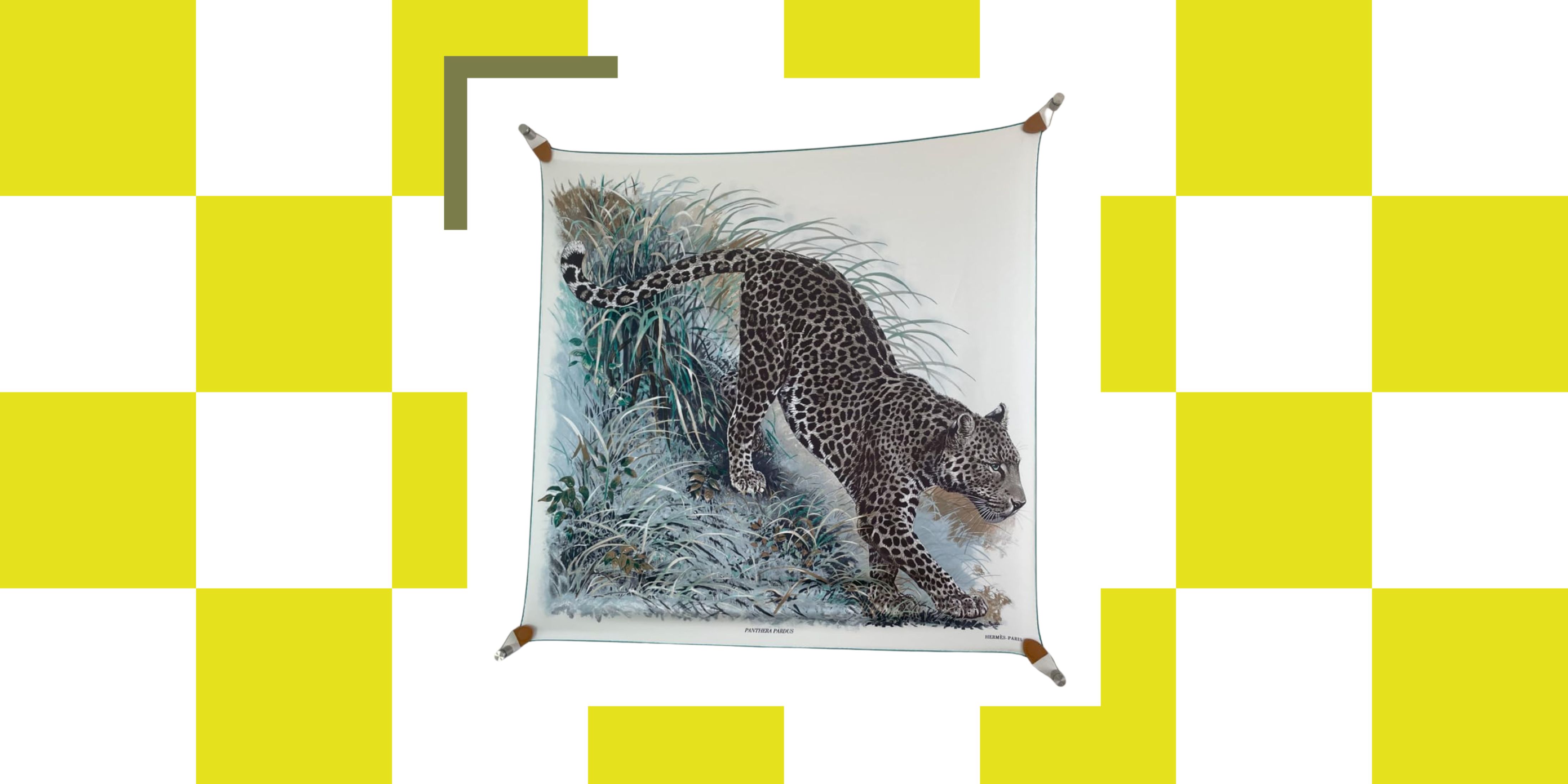 The Easiest Way to Turn Your Designer Scarf Into Wall Art — No Frame, No Fuss, No Regrets
The Easiest Way to Turn Your Designer Scarf Into Wall Art — No Frame, No Fuss, No RegretsBecause silk this pretty should never stay in a drawer
By Julia Demer Published
-
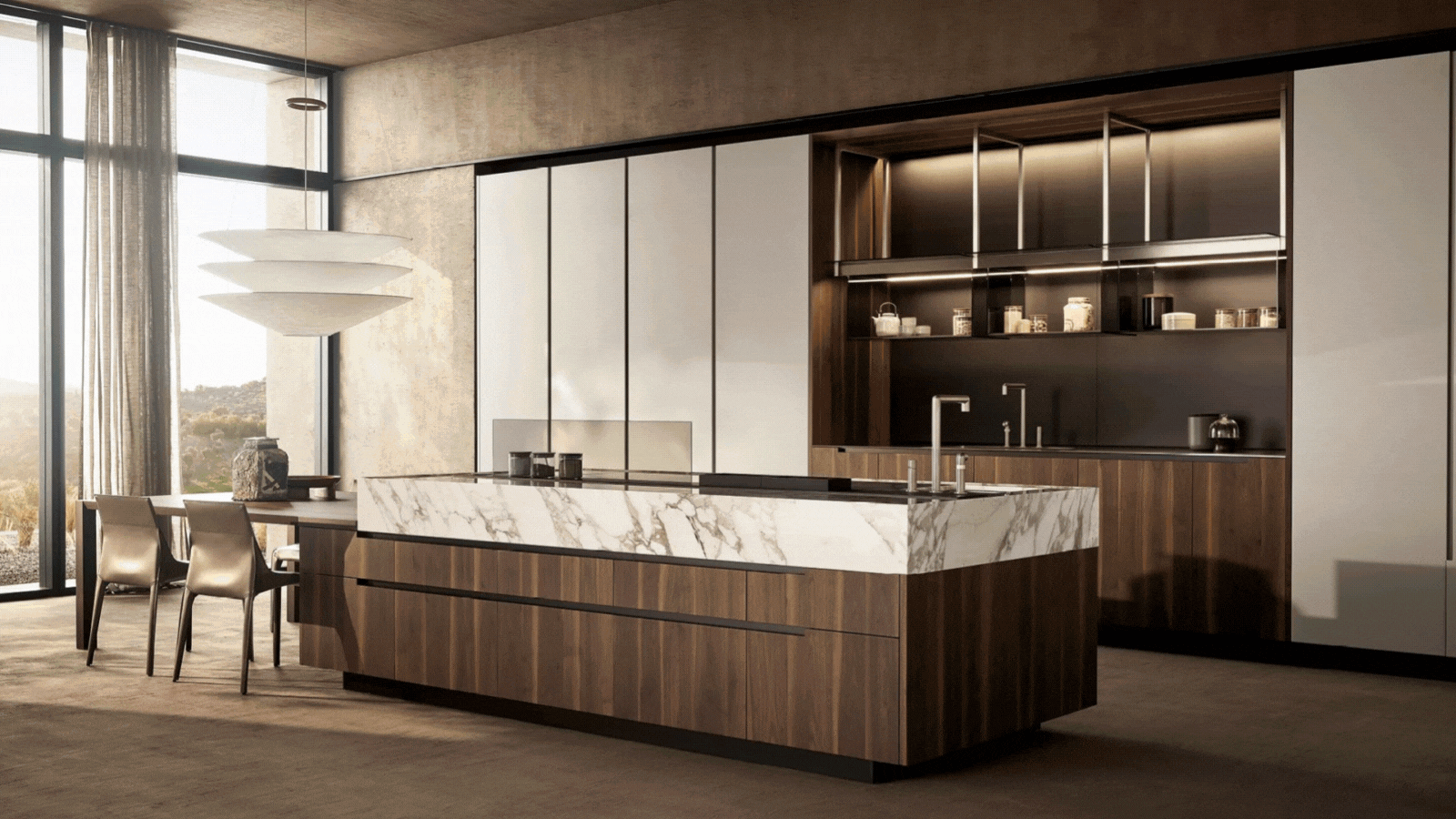 Italian Kitchen Trends — 5 Emerging Ideas From the Chicest Italian Designers That I Predict Will Go Global in 2025
Italian Kitchen Trends — 5 Emerging Ideas From the Chicest Italian Designers That I Predict Will Go Global in 2025Fresh from Milan Design Week, these are the exciting finishes, styles, and innovative materials I can't wait to see in more kitchens this year
By Faiza Saqib Published
